Discover essential tips and precautions for traveling with a newborn. Specifically, this comprehensive guide covers everything from necessary documents to must-have packing items, ultimately helping to ensure a smooth and enjoyable journey for both you and your little one.

Travel is Fun!
Traveling with a newborn can be an incredible adventure, bursting with special moments and exciting new experiences! Sure, it might come with a few challenges that could make you feel a bit anxious, but don’t fret! With a dash of smart planning and some handy preparation, you can conquer those challenges and create unforgettable memories together.
To kickstart this amazing journey, we’ve crafted a lively and informative guide packed with tips to make your travels smoother and more fun for both you and your little one. Let’s hit the road and make some magical memories!
Essential Documents
Before you hit the road or take to the skies, it is important to ensure that you have all necessary documents prepared:
- Passport:
- Start the application process early, as it can take time. In fact, many countries require a passport for infants, even for domestic flights.
- Visa:
- Additionally, check the visa requirements for your destination. Some countries may require a visa for infants, so it is wise to apply in advance if needed.
- Birth Certificate:
- Furthermore, carry a copy of your baby’s birth certificate, especially if you’re traveling internationally. This can help verify age for airline policies.
- Immunization Records:
- Keep a copy of your baby’s vaccination records handy, as some destinations may require proof of vaccinations.
- Medical Consent Form:
- If you are traveling with a healthcare provider or if someone else is responsible for your baby, consider having a medical consent form signed.
Cultural Considerations
When you travel to different countries, especially those with unique customs about babies, it’s really important to keep your child’s birth certificate and vaccination records handy. For example, many cultures have special celebrations for newborns. Knowing about these traditions can help you connect with local families. Also, how people view breastfeeding can be very different from what you’re used to at home. By researching local customs, you’ll be better prepared to adapt your practices. This will help you feel more comfortable in new places.

Understanding how people interact with kids can make your trip even better. For instance, in many Latin American countries, it’s normal for strangers to come up to your baby with big smiles and gentle touches. This shows how friendly the culture is. On the other hand, in places like Japan, people usually like to keep their distance and respect family space, which can feel quite different!
Imagine walking through a lively market in Mexico. You might see locals stop to admire your little one and share happy compliments. It creates a fun and welcoming atmosphere! Meanwhile, in a peaceful park in Japan, parents might let their kids explore while staying a little back. By noticing and respecting these differences, you’ll have a richer travel experience and make some unforgettable memories with the locals!
Packing Essentials for Your Diaper Bag
A well-packed diaper bag can be a lifesaver when traveling with a newborn. Therefore, it’s essential to have everything you might need easily accessible to ensure a smooth journey.

Here’s a detailed checklist of must-have items for your diaper bag:
- Diapers
- Quantity: Pack enough for the entire trip, plus extra for unexpected delays. A good rule of thumb is one diaper for every hour of travel, plus a few extras.
- Size Consideration: Make sure to pack the correct size based on your baby’s weight.
- Wipes
- Quantity: Bring a full pack of baby wipes. These are versatile for diaper changes, cleaning hands, and wiping surfaces.
- Sensitive Options: Consider hypoallergenic or sensitive skin wipes if your baby has any skin sensitivities.
- Diaper Rash Cream
- Prevention: Use a good quality diaper rash cream to prevent and treat any rashes. Look for products with zinc oxide for effective barrier protection.
- Travel Size: Consider carrying a travel-sized tube to save space.
- Formula or Breast Milk
- For Formula-Feeding: Pack enough formula in pre-measured containers or ready-to-use bottles. Don’t forget a portable bottle warmer if needed.
- Breast Milk: If breastfeeding, bring an insulated cooler bag to keep expressed milk fresh. Also, check airline policies for transporting breast milk.
- Bottles and Nipples
- Quantity: Bring at least two clean bottles, along with extra nipples. Make sure they are easy to clean and refill.
- Bottle Brush: A small bottle brush can help you clean them if needed during your travels.
- Pacifier
- Comfort Item: A pacifier can help soothe your baby during takeoff, landing, or times of fussiness. Therefore, bring at least one spare.
- Clip or Holder: Consider a pacifier clip to prevent it from falling on the ground.
- Burp Cloths
- Quantity: Pack a few burp cloths for feeding spills and spit-up. Look for absorbent materials that are easy to clean.
- Change of Clothes
- For Baby: Bring at least four complete outfits (including onesies, pants, and socks). Babies can have unexpected messes, so be prepared.
- For Parents: Include an extra top for yourself in case of spills or accidents.
- Blankets
- Types: Bring a couple of quick-dry blankets for warmth and comfort. They can serve multiple purposes—swaddling, covering during feedings, or as a play area.
- Lightweight Options: Consider lightweight, breathable fabrics for easier packing.
- Socks and Mittens
- Socks: Pack a few pairs of socks to keep your baby’s feet warm, especially in cold environments like airplanes.
- Mittens: Include mittens to prevent your baby from scratching their face.
- Jackets
- Lightweight Options: Depending on the climate, bring a lightweight jacket or hoodie to keep your baby warm during travel.
- Toys and Activities
- Entertainment: Include a few small, lightweight toys or rattles to keep your baby entertained during the journey.
- Sensory Toys: Soft toys with different textures or sounds can engage your baby’s senses.
- First Aid Kit
- Essentials: Include infant pain relievers, a thermometer, and any necessary medications. Moreover, a small first aid kit with band-aids and antiseptic wipes can also be helpful.
- Documentation: Keep a copy of any prescriptions or important medical information.
- Hand Sanitizer
- For Parents: Bring a travel-sized hand sanitizer to keep your hands clean, especially after diaper changes or before feeding.
- Snacks and Healthy Food for Yourself
- Energy Boost: Pack some healthy snacks for yourself to keep your energy up while managing your baby’s needs. Options like granola bars, nuts, or dried fruit are great for travel.
- Ziploc Bags
- Organization: Use Ziploc bags to keep items organized and separate. They can be used for storing dirty clothes, used wipes, or snacks.
- Disposable Diaper Bags
- For Clean-Up: Bring a few disposable bags for easy disposal of dirty diapers and wipes while on the go.
- Portable Changing Pad
- Convenience: A foldable changing pad can provide a clean surface for diaper changes, especially in less-than-ideal locations.
- Emergency Contact Information
- Documentation: Keep a card with your emergency contacts, pediatrician’s info, and any pertinent medical information for your baby.

Essential Gear for Comfort and Convenience
- Pram/Stroller:
- Choose a lightweight, foldable pram or stroller that’s easy to carry and maneuver. Furthermore, look for models that recline to help your baby sleep comfortably during your travels.
- Kangaroo Bag (Baby Carrier):
- A comfortable baby carrier can be a lifesaver for navigating busy areas. It allows you to keep your hands free while keeping your baby close. Plus, it’s great for soothing your little one to sleep while on the go.
Important Airport Precautions
- Arrive Early:
- Give yourself ample time to check in, go through security, and handle any unexpected delays. Arriving early reduces stress and allows for any necessary diaper changes or feedings.
- Prepare for Security Screening:
- Familiarize yourself with TSA guidelines regarding traveling with children. You may need to remove your baby from a carrier or stroller for screening. Therefore, have all essentials (diaper bag, stroller) easily accessible for inspection.
- Use a Lightweight Stroller or Carrier:
- Opt for a lightweight, foldable stroller or a baby carrier that allows for easy maneuvering through crowds and quick storage when needed.
- Keep Essentials Within Reach:
- Organize your diaper bag so that frequently used items (diapers, wipes, pacifiers) are easily accessible. This way, you can quickly tend to your baby’s needs without rummaging through your bag.
- Utilize Baby Care Facilities:
- Look for baby care rooms at the airport, which often provide changing tables, nursing areas, and other amenities. These spaces can offer a more comfortable environment for diaper changes and feedings.
- Stay Informed About Flight Updates:
- Keep an eye on flight status updates via the airline’s app or airport monitors. Staying informed helps you avoid last-minute rushes.
- Consider Your Baby’s Schedule:
- Plan around your baby’s feeding and sleeping schedule. If possible, schedule flights during times when your baby is likely to be sleepy.
- Hydration and Snacks:
- Stay hydrated and pack snacks for yourself. It’s easy to forget to eat or drink when focused on your baby.
- Maintain Calmness in Crowds:
- Crowded spaces can be overwhelming. Therefore, try to stay calm and maintain a soothing environment for your baby. Use a baby carrier if needed to keep them close.
- Contact Airport Staff if Needed:
- If you require assistance—whether it’s help with luggage or directions—don’t hesitate to approach airport staff. They are there to help.
- Emergency Preparedness:
- Keep a small first aid kit handy, including infant pain relievers, a thermometer, and any necessary medications. Being prepared for minor health issues can ease worries.
- Know Your Airline’s Policies:
- Check your airline’s policies on traveling with infants, including baggage allowances, car seat usage, and any other specific requirements.
- Reach Out to Flight Attendants:
- Don’t hesitate to contact a flight attendant if you need assistance during your flight. They are trained to help with various needs, from finding a suitable space for diaper changes to providing extra supplies like water or snacks.
- Inform the Airline About Your Needs:
- Let the airline know in advance that you are traveling with a newborn. This can help them provide special assistance, including priority boarding if available.
- Special Treatment for Lap Infants:
- If your baby is a lap infant, inquire about any additional seating options. Some airlines may offer extra space for families.
- Be Aware of Boarding Procedures:
- Understand the airline’s boarding procedures and whether families with young children can board early. This can ease the transition onto the plane.
- Plan for Takeoff and Landing:
- During takeoff and landing, consider breastfeeding or using a pacifier to help equalize your baby’s ear pressure. This can minimize discomfort.
- Dress Comfortably:
- Dress your baby in layers for the flight, allowing for adjustments based on temperature changes on the plane.
Safe Road Trip Tips
When planning a road trip, whether in your own vehicle or using public transport, keep these precautions in mind:
- Car Seat Safety:
- Ensure your baby’s car seat is properly installed and meets safety regulations. Always buckle them in securely for the journey.
- Frequent Breaks:
- Plan for regular breaks to allow your baby to stretch, be changed, and fed. This will help keep them comfortable and happy.
- Comfort Items:
- Bring along familiar items like toys or blankets to provide comfort during the trip.
- Monitor Weather Conditions:
- Check the weather forecast to prepare for any changes that may impact your travel.
- Emergency Kit:
- Keep an emergency kit in your vehicle, including a first aid kit, extra diapers, wipes, and snacks for both you and your baby.
- Stay Hydrated:
- Remember to stay hydrated yourself and keep a supply of water and snacks accessible.
- Plan Your Route:
- Choose a route with rest areas or family-friendly stops to make the trip smoother and more enjoyable.
- Prepare for Delays:
- Stay patient and prepared for any delays, as traveling with an infant may require more time than anticipated.
- Car Ventilation:
- Ensure proper ventilation and temperature control in the vehicle to keep your baby comfortable.
- Keep Essentials Accessible:
- Keep your diaper bag and other essentials within easy reach for quick access during the trip.
Local Customs During Your Road Trip
As you set off on your epic road trip, get ready to dive into the fascinating world of local customs that can truly shape your adventure! For instance, in many areas, it’s super common to stop at quirky roadside stands or bustling markets, where you can munch on delicious, fresh snacks. Just imagine savoring homemade jams or juicy fruits picked straight from the farm!
Additionally, the way people react to kids can vary quite a bit. In some cultures, children are celebrated like little stars and receive tons of attention, whereas in others, folks might prefer a bit more personal space. Understanding these local vibes not only makes your trip more enjoyable but also helps you connect with new friends along the way. Therefore, keep your eyes peeled for unique customs, and get ready to create some unforgettable memories!
Enjoying the Journey Together
Traveling with your infant can be one of the most beautiful experiences of your life. By staying organized, packing thoughtfully, and being mindful of airport protocols, you can create a smoother journey for both you and your baby. Remember, flexibility is key—plans may change, and that’s perfectly okay. Focus on enjoying the journey and the special moments you share with your little one. With these tips in hand, you’re well-equipped to embark on your adventures together, creating cherished memories that will last a lifetime. Safe travels!